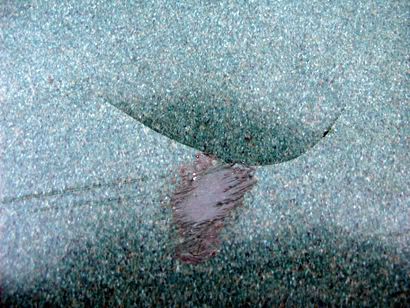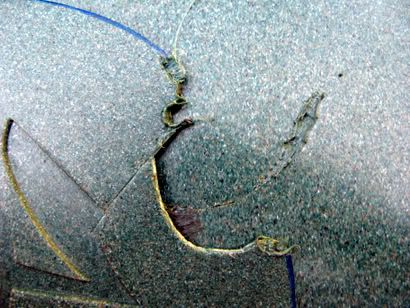
The other day I was packing my future brother in laws (Just a guess, honest) trailer with loads of kayak goodies to take on our annual Australia Day long weekend adventure (Just so happened to be Bemm river this time, coincidence?) when I discovered a new type of pain. My beloved Hobie Quest, that has served me so well for years, was wounded. When we flipped the craft over to load top down I noticed a rather large puncher wound on the rear of the kayak. It was the size of a cricket ball and resembled the impact with two fractures running in differing 90 degrees.
The kayak is four years old and in top condition, only collecting the usual scrapes and bumps throughout its life. What’s changed in its life, surely I would have noticed last time I used it that it had a massive hole in it. Since I got the Pro Angler in late October the Quest has been lieing dormant in its usual position in my garage against the wall (On its side). In early January I had rearranged the garage in hope of fitting my car back inside, I failed but developed a system cable tieing some Aquaracks under the shelf that holds the Outfitter (Three yak tiered on levels).
Looking back at the yaks wound and where it had lay beforehand I realised the amount of additional weight that had been placed on the Quest while working on my car. I also realised the heat of our summer had the garage holding above 40 degrees for hours and weeks on end, that’s also when I noticed the end of one Aquarack had rolled around to produce an obtuse end. It lined up perfectly with the hull split and suddenly it all made sense. It was no warranty claim, no failure of product just my complete lack of attention to the Quests proper storage.

Aquaracks are a good product but mine was installed incorrectly (By myself I might add). I wont put pictures of my garage up for all to see but rest assured its a squeeze in the best of times. The top shelving which holds the Outfitter is supported by triangle style mounts, the Aquaracks were cable tied underneath to these fittings and the Pro Angler lies flat underneath. The problem with this setup (Even though it looks something special) is the top shelves triangle mounts prevent the Quest underneath to sit on the Aquarack the way the designers intended to.
I had compensated in the wrong area, not noticing that the weakest point of the Quests hull would be so exposed with the way the kayak sat. Rather than supported vertically like on a J bar system I sat the kayak like a baby being cradled in its mothers arms for the first time (Awkwardly). Take into account the constant heat and extra weight and hey presto, we have a problem. I wasn’t as pissed off as I normally would be due to finding out about the hole before we had left (If I was by myself I probably would not have noticed, at all) and I was kind of excited about the prospect of trying something new.
The hull needed to be repaired and I studied my options online and considered alternatives. Sure a bumper bar repair man plastic welder by trade thingy dude could have fixed it, maybe even as good as new. But I wanted to try, I had been thinking about it for years but the situation never arose. I almost practiced on a bin once but got distracted by real tasks. What I am talking about is the back to basics polyethylene hull repair that will work but appear messy. The bear bones fix was to employ the use of a soldering iron, hairdryer and some kayak off cuts. Owning only the latter two things needed to commence operation I called the brother in law and limped the kayak round to his man cave.

I got stuck into right away, the kayaks wound could have been a lot worse after all. I heated the hull with a hairdryer from the outside which raised temperatures inside the hull enough to realign the cracks, using cut to shape wood chucks to hold hull alignment inside into position. Before I Used a large hatch off cut I had kept from years ago I firstly created a zig zag stitch seam starting at one end of the crack before retracing my tracks by following the contours of the break right down the middle. I found the stitch helped bind into position but the trace sealed beyond face value (Other words, deeper). Then, just to be sure, I melted and rubbed additional blobs from the hatch in cross hatching patterns; it wasn’t pretty but sure looked watertight. Using a torch I checked the inside and repeated the process, wiping the area with a damp cloth before continuing to stitch.
Nothing more to it really, the result was tested out and the kayak was indeed watertight. Perhaps with less excitement and more planning I could have done a neater job, but neater compared to what? The repair work was carried out on the hull of a four year old Hobie Quest that had been riddled and rasped over boulders and boundaries galore. It’s really not pretty under there so the effect kind of warrants that ‘Used’ look, no problem as it was never being sold and is still my kayak of choice in rivers and local lakes.
The pictures don’t really do the work justice but it’s worth a view all the same...



